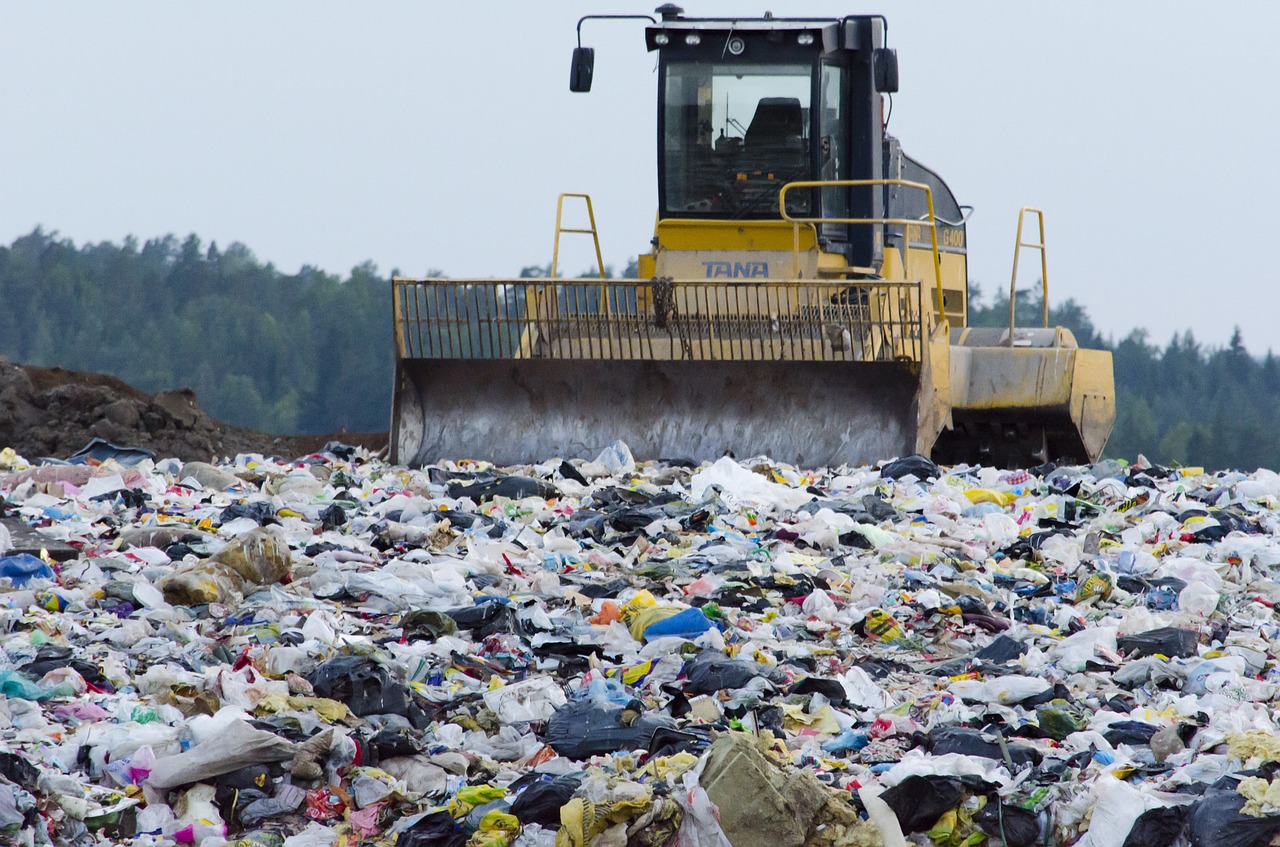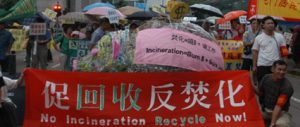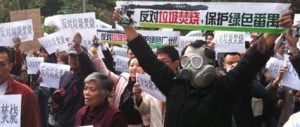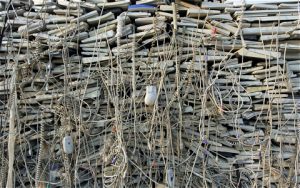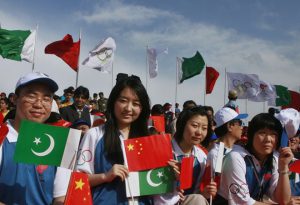Yan Xiaowei 闫笑炜 is the winner of chinadialogue’s 2016 China Environmental Press Awards ‘Best Green Economy’ prize.
This story was originally published in the Energy Magazine on December 25, 2015.
Drive half an hour west on the city ring road from Donghuang and you pass the small town of Hengli in southern China's Guangdong province. Five kilometres further on you reach a walled-off industrial site, where a yellow and blue company flag snaps in the breeze alongside the Chinese flag. A screen on the wall updates constantly with the latest dust and sulphur dioxide data, while smoke pours from chimneys behind the walls. And all is silent, apart from the sound of trucks of waste being unloaded.
This is the largest waste-to-energy plant in the Pearl River Delta – the Hengli Waste Incineration Plant. It belongs to Donghuang Kewei Environmental Electricity, a subsidiary of the Canvest Group. In September this year the plant was upgraded from a circulating fluidised bed (CFB) boiler to use water-cooled vibrating grate technology.
The waste-to-power gold rush has been developing since China’s first such power plant was built in Shenzhen in the late 1980s. With increasing quantities of urban waste to deal with and rapidly filling landfill sites, waste-to-power was seen as the best prospect. Waste took on a new role – not just a problem to be got rid of, but a part of a less wasteful ‘circular economy’, a new resource which could supply constant electricity in the simplest and most cost-effective of ways.
But no industry can escape its fate. After 10 years, controversy is raging about the waste-to-power sector. Despite their status as part of the circular economy, these facilities are accused of fraudulently obtaining government waste disposal subsidies and have repeatedly come in for criticism over environmental concerns.
In November 2015, an investigation by Energy Magazine of a number of Chinese waste-to-power projects found that, like the Hengli plant, there are complex vested interests and unwritten rules at work.
Rules of the game
In early November Zhang Mingyuan (not his real name) made an important trip – to an environmental exhibition held at Xi’an’s International Exhibition Centre. There, he spoke to visitors to his stand about his company’s record and technology.
But Zhang, the chairman of a waste-to-power firm, had another reason to visit Xi’an – bidding for a local waste-to-power project was soon to start, and he wanted to ensure his firm was classed as a qualified bidder.
Not long previously Xi’an had announced it needed five new waste-to-power plants. According to Xi’an Environmental Protection Group, the city produces an average of 7,000 to 8,000 tonnes of urban waste daily – up to 9,000 tonnes in summer. Most of this is buried in landfill sites – but these are becoming full and the local government plans to use waste-to-power plants as an alternative. Five such plants, incinerating an average of 2,000 tonnes of waste per day, would be needed.
The expanding environmental protection industry, increasing quantities of waste and shortage of landfill capacity have brought changes for the waste-to-power sector.
Waste-to-power plants are much less expensive than the myriad wind and solar power projects already underway, which can easily cost 100 million yuan; and unlike traditional biomass power generation, there is a stable source of fuel and easily available technologies. Generous government subsidies for waste disposal have provided an incentive to plant operators to ensure that an ample supply of fuel and income is guaranteed.
An increasing number of investors have been lured by the opportunity to profit both from those subsidies and the sale of electricity.
Zhang’s company built Donghuang’s first waste-to-power plant in the late 1990s and he is regarded by many in the industry as a senior figure. But unlike in earlier more confident days, his firm has little hope of securing a contract in Xi’an.
“It’s been years since I invested in new waste-to-power projects – we don’t have the competitive advantage anymore,” he admitted.
Over the years local protectionism has meant fewer and fewer contracts – and just bidding for the contract is hugely expensive.
Not long ago he bid for a 1,400 tonne a day waste-to-power project in Yongzhou, Hunan. The entire process, from initial research to submitting a bid, cost over 8 million yuan. Alongside preparing documentation and carrying out research, another major expense is establishing the right relationships with different levels of government.
“I remember at the time someone in the family of one of the heads of the local environmental bureau was getting married, and so we gave them a gift. There’s a crackdown on that kind of thing now, so you can’t put your name on it, and if they’re not sure of you they won’t even accept it. And once you’ve handed it over you can’t even stay for the meal, you need to leave right away.”
Despite all that, his company did not win the contract – it went to a competitor with a background in state-owned enterprises.
He also feels that tenders are now more likely to be sewn up in advance. The profits on offer have lured businessmen with existing links to government – despite having no experience and so not being qualified bidders. One industry insider who preferred to remain anonymous, explained: “there are three factors that determine whether you win or not: your connections, your technology, your price. There’s not much difference in the technologies nowadays, so it’s mainly down to your connection and price.”
Bidders for a new project are generally required to be operating waste-to-power plants disposing of at least 500 tonnes of waste per day. This appears to ensure all bidders are up to standard, but there are loopholes:
Zhang explained how it works: “Say you’ve got six qualified bidders and 10 unqualified companies that also want to bid, when the government is issuing the bid they’ll add a note allowing joint bids then quietly tell a qualified bidder to team up with one of the unqualified ones. Once the bid is won, the unqualified bidder shares in the profits and can claim that project as their own; that’s how a lot of the existing companies got started. Once they have that project to their name they can go and get other contracts elsewhere. Many of those companies are brought in by friends and relatives of government officials.”
The project owner is often a sanitation company owned by local government, and the outcome of the bidding process is usually in line with government preference. It may look like the winner was selected by an evaluation committee, but the experts on that committee are carefully selected and have limited impact on the outcome. Anyone who is uncooperative won’t be invited to participate in the future, and the experts need to make their choice according to criteria set by the government.
One company that operates CFB waste-to-power plants said that “sometimes there might be a company with government links that’s using water-cooled vibrating gate technology, so the government specifies that technology must be used to exclude all the firms using CFB.” Thus the government authorities ensure their favoured company is chosen to win the build-operate-transfer contract.
Zhang shakes his head when asked about the Xi’an contract and is unwilling to say much. “A total of twenty firms participated, and it’s very hard to compete with the locals.”
If it wasn’t for Zhang speaking out, these unwritten rules would be known only to the industry. But even if a company does win a contract, will the waste they need to burn to make profits actually arrive as promised? Perhaps not…
Shady interests
At the waste-to-power plant in Xingyi, Guizhou, blue and white trucks carrying 20 tonnes of waste each drive into a huge hall to unload.
This plant is designed and operated by the Hongda Environmental Electricity Group. Power generated here is fed to the city’s supply, while ashes from the incinerators are used to make building materials. The first stage of the project was designed to dispose of 700 tonnes of waste daily and generate 140 million kilowatt hours of electricity a year.
But rather than its designed capacity of 700 tonnes of waste a day, it is only handling about 500 tonnes.
An industry insider, preferring to remain nameless, helped with the calculations “Waste-to-power profits come from electricity sales and waste disposal subsidies. Costs include the purchase and maintenance of equipment and staff. Those costs are basically fixed, but income depends on how much waste you process. Generally you need 600 tonnes a day to break even. Some experts say that should be 1,000 tonnes, as in some places the waste is different, it contains less energy or doesn’t burn so well, or different technologies are used. But looking at the numbers, at 500 tonnes a day Hongda isn’t breaking even.”
There are other factors which mean location is crucial to profitability. Li Deming, chief engineer with Canvest Group subsidiary Kewei Environmental Electricity said that “early waste-to-power plants were all built in developed areas, the Yangtze and Pearl River deltas, where there’s plenty of waste with a high heating value and well-off local governments. Plants operate at full capacity so they’re very profitable. Our plant in Donghuang burns 2,000 tonnes of waste a day. We invested about 600 million yuan in upgrading it, but we’ll get that back in eight years.”
But profitability is a different matter further inland. Ren Guanghui, deputy general manager of the Jinjiang Group, has commented: “Using the waste-to-power plant at Heze in Shandong as an example: planning for energy demand is weak so we’re only generating power 35% of the time; generating power from waste costs 0.397 yuan per kilowatt hour and there’s a temporary price in place of only 0.285 yuan. Add in the fact that promised government waste disposal subsidies are late (10 yuan should be paid for each tonne of waste incinerated) and that means temporary losses.” Industry insiders have also revealed that the Jinjiang group is considering selling off unprofitable projects.
The Jinjiang Group originally produced textiles, but bought a power plant to supply its own needs during an electricity shortage. The plant was bought cheap and then upgraded with CFB technology so it could use waste as fuel. This accidental purchase resulted in huge profits for the Jinjiang Group. As it expanded inland things changed, however – local governments aren’t so well-funded, electricity prices and waste disposal subsidies are different, and those subsidies may not be paid on time. This all affects profitability.
Nor is the Jinjiang Group unique. Guangda Group, another leading waste-to-power operator, has profitable plants in the Yangtze and Pearl deltas, but further inland it suffered from problems with the supply of waste and payment for electricity.
“Zhang commented that “how the government handles waste is crucial, as this determines profitability.”
For example, waste-to-power arrangements in Kunming have been criticised by the industry. Kunming was one of the first to run a waste-to-power tendering process, in 2008. Under the plans the city’s four districts would be producing 7,000 tonnes of waste daily, with five waste-to-power plants needed. Contracts went to local firm Yunnan Huanneng Electricity, the Jinjiang Group and Zhongde Environmental Protection.
One local industry insider explained: “We did our planning based on the government figures, assuming there’d be no problem with acquiring waste, but once we were up and running we weren’t getting anywhere near those figures. There are too many power plants and not enough waste – some with capacity for 1,000 tonnes of waste per day are only getting 500 and running at a loss.”
Although many second and third tier cities are considering using waste-to-power plants to dispose of increasing quantities of waste, those in the industry think the number of suitable locations is shrinking.
But different firms take different approaches. One insider, preferring to remain anonymous, pointed out that “The Guangda Group is state-owned and gets financial backing from the State-owned Assets Supervision and Administration Commission. It also has listed subsidiaries and a complete industry supply chain, so it doesn’t worry about whether one particular project is profitable or not. But Jinjiang is profit-driven, so it might think about selling off some less profitable operations, and its business is gradually shifting towards the aluminium sector.”
The money pile
So while some companies are taking a cautious approach, others are expanding as fast as they can. Energy Magazine found that those expanding fastest in recent years have been listed companies.
Generally waste disposal subsidies determine if a plant will be profitable if high return on investment is faster. But some rush in even when subsidies are low. In August the Dyangreen Group won a BOT waste-to-power contract in Bangbu, Anhui, by proposing a subsidy of 26.80 yuan per tonne of waste incinerated – a new low for a BOT grate furnace project. And less than two months later another new low was set, of 26.50 yuan, when Tianjin Taida won a contract in Gaoyou, Jiangsu.
The first signs of this trend appeared in the early 2000s. In 2001 the subsidy for the Heze plant in Shandong, the first such BOT project, was set at 8 yuan a tonne. Later subsidies of 20 yuan, 30 yuan and 40 yuan were set for other projects. There is currently an ongoing price war, with government-proposed subsidies in tender documents ignored. “You’re doing well in most bids if you get 50% of the guide price, in extreme circumstances it can be as little as 10%,” Zhang explained.
The listed firms, in comparison to their non-listed counterparts, have an ample supply of funds. But there are various motivations for the expansion.
One anonymous industry insider revealed that “not long ago a well-known SOE formed a waste-to-power department and got in touch to ask if we had any projects we could sell them. They were in real rush, as they wanted to have a plant that would allow them to qualify to bid for other projects. They said they’d even taking something only incinerating 400 tonnes a year and making a loss. For the state-owned enterprises it just means they can bid on other projects and make huge profits there.” This is why many firms which win contracts then sell them on at higher prices.
Xu Haiyun, chief engineer at the China Urban Construction Institute, says that “waste-to-power is something the public is currently keen to invest in, which is good for the listed companies. Some investors who’ve chosen the wrong technology can easily sell off 25 or 30 year operating licences or just start all over again with new waste-to-power incineration technology.
The investors don’t suffer any losses, they just pass the losses on to the government or state-owned firms. They know the government is going to look out for investors, so they’re not worried. There’s also a lack of social trust, which aids speculation. As long as you’ve got a story to tell on the capital markets, your share price goes up.”
Zhang said that “the companies have been getting smarter, with some even learning how to force the government to raise subsidies. Say they’ve got a plant that isn’t profitable and isn’t meeting emissions standards. They arrange for media coverage, which puts the government under pressure, forcing it to pay for equipment to clean up emissions and temporarily increase waste disposal subsidies to 120 yuan a tonne.”Selling projects on is one approach. One other used by many listed firms with good funding is to win a project and then fail to carry out construction, citing local opposition.
“According to one anonymous industry insider, “the question now isn’t one of technology, it’s whether or not you actually go into operation once you’ve won the bid. If you run the plant well there won’t be any problems, including with emissions. A waste-to-power plant can mean a lot of hidden benefits for the locals – environmental compensation, compensation for land, etc. But if those payments aren’t made they’ll protest.”
Protests put local governments under huge pressure, but give companies a good reason to shelve projects. It’s usually the case that having won a contract, the company can apply for subsidies, and once approved can obtain bank loans. Many companies get those loans, then spend the money on other projects. “Four companies won contracts in Kunming, but one listed German company has just put off construction and is now a property developer,” said one insider.
Xu Yunhai thinks that the government is tolerating excessive competition and expansion. And the lack of landfill capacity is also driving the waste-to-power sector and determining whether projects will be smoothly implemented. Yet why are these firms, which rely on the demand to protect the environment, often criticised on environmental grounds?
Emissions misreporting is common
On November 19 we were given a tour of Kewei Environmental Electricity’s newly-built Donghuang plant by site director Chen Feng. The air here carries on unpleasant odours, unlike the stench of a landfill site, and environmental slogans adorn the walls. A screen is updated every five seconds with the latest nitrogen oxides and sulphur dioxide monitoring data. Just before we start Chen makes a point of washing his hands in a fountain, telling us the water is recycled from the factory and is perfectly clean.
In 2014 the Ministry of Environmental Protection issued a standard for pollution from the incineration of domestic waste, prompting many firms to upgrade their facilities. The results were immediate. The screen shows dioxin emissions are at 0.1ngTEQ per cubic metre – meeting even EU standards.
But when we finish our tour and are deciding where to eat, one of the experts in the group still suggests eating somewhere away from the plant.
“The numbers are often manipulated,” said one industry insider with twenty years of experience. “Never mind what they’re up to, I managed a plant for years and I’ve done it all. It’s not that you can’t remove dioxins, it’s just that they’re very hard to detect.”
The make-up of the waste received is very variable – waste sourced from the same location, being incinerated at the same plant, can be affected even by the weather. Wet weather means wetter waste, less efficient incineration, and so more emissions and ash, than in dryer times. This means you can’t calculate emissions based on what’s being burned. Often the environmental authorities use active carbon to measure dioxin levels – the material absorbs dioxin particles well. So the only way to determine if a waste-to-power plant is meeting emission standards is to look at how much active carbon it’s using.
And that’s where the trick is,” said the same source. “In the days prior to their visit we use more active carbon – it means we don’t have to use too much of it, but we can meet the environmental standards.”
Some companies even build nearby offices for the environmental authorities to that when higher-ups visit they can show how environmentally friendly they are. And because of the vested interests involved with the plants, the environmental authorities sometimes turn the other cheek.
Dioxins aren’t the only issue – handling of ash from the incinerators is also becoming a problem.
Not long ago complaints were made about ash from the Guangda Group’s 14,000 tonne a day waste-to-power plant in Jiangyin, demonstrating the problem this issue causes.
The ash has high levels of heavy metals, which are not burned during incineration, and for this reason ash is listed as a type of hazardous waste. The main method of disposal currently is to collect the ash, mix it with concrete, and then bury it. But given decreasing landfill capacity, this approach has been called into question.
Chen Feng explained that “the problem is one of technology and cost, and it’s something we’ve always been working on. But currently we outsource disposal of the ash to Veolia, to avoid any problems if we don’t deal with it properly. As to what Veolia does with it, that’s their affair.”
Waste-to-power plants claim to be part of the circular economy, but are suspected of fraudulently obtaining state subsidies and have repeatedly been criticised on environmental grounds.
Editor's Note: Power generation can be a sensitive topic in the environmental sector, along with “dams” and “PM2.5” – it brings to mind protests and ‘NIMBY’ activism. For the industry, “the ideal solution for dealing with urban waste is to incinerate it and produce and electricity.” But as China becomes greener it must discriminate carefully between its different options. The environmental press has often written about local protests against waste-to-power plants, but it is rarer to see an in-depth investigation into the industry as a whole. Energy Magazine’s Yan Xiaowei gained access to a number of such plants and revealed the shady interests and unwritten rules at work.
